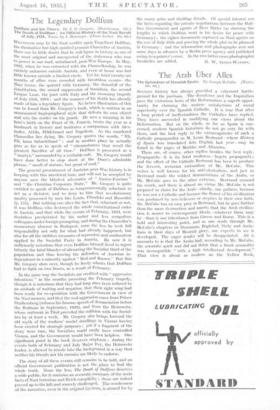The Legendary Dollfuss
WITATEVER may be the final verdict, upon Engelbert Dollfuss, the diminutive but high-spirited peasant-,Chancellor of Austria,. there can be little doubt that he will figure in history as one of the most original and unexpected of the statesmen who rose to power in our mad, unbalanced, post-War Europe. In May, 1932, when he was entrusted with the Chancellorship, he was entirely unknown outside Austria, and even at home was but little known outside a limited circle. Yet his brief twenty-six months of office were crowded with breathless events—the Nazi error; the qUariel with Germany,Ahe doWnfall of the eonsti l u I ion, the armed suppression of Socialisrii, the second League 'Loan, the pact with Italy and the crowning tragedy of July 25th, 1934 : and the manner of his death has already made of kiln a legendary figure. No better illustration of this can be found than Mr. Gregory's boOk, which is written in an untheastired liagiographical style that defeats its' own object and sets the reader on his guard. - He sees a meaning in his here's .birth on the Feast of St. Francis, treats the year as a landmark in history and institutes a comparison with Alex- ander, Attila, Hildebrand and Napoleon. As the murdered Chancellor lies dying, Mr. Gregory quotes the words, " Eli, nli; lama Sabachtheni " : and in another place he actually goes' so far as to ' speak of " circumstances that recall the greatest Sacrifice of all time." Dollfuss is presented as a ".thartyr," surrounded by a veritable cult. Mr. Gregory would have done better to stop short at the Duee's admirable phrasei. " small of stature, but great of soul."
The general presentment of Austrian post-War history is in keeping with this uncritical tone, and will not be accepted by anyone save 'the blindest advocates of " Austro-Faseism " and " the- Christian Corporate State:" Mr. Gregory is quite entitled to speak of Dollfuss as temperamentally reluctant to t as a dictator, and to deny to him that revolutionary quality possessed by men like Lenin, Pilsudski and Mussolini (p. 155). But nothing can alter the fact that, reluctant or not, it was Dollfuss who destroyed the whole constitutional order hi Austria, and that while the events of February, 1934, were doubtless precipitated by his rasher and less scrupulous colleagues under foreign prompting, and during the Chancellor'S MOthentary absence in Budapest,: none the less he took full responsibility not only for what had already happened, but alSo for all the ruthless measures of repression and confiscation applied to the Socialist Party in Austria. By now it is Sitilibiently notorious that even Dollfuss himself lived to regret bitterly the fatal bliincler of alienating the Socialist third of the PoPtilatiOn and thtis.- leaving the defenders of Austrian in- dependenee in a Minority against " Red and Brown." But this Mr. Gregory slurs Over, though he freely admits that Dollfuss had te' fight on two` fronts, as a result of February. In the same way the Socialists are credited with " aggressive intentions " in the months preceding the February tragedy, though it is notorious that they had long, since been reduced to an attitude of. waiting and negation, that their right wing had been ready for co-operation with the Government in view of the Nazi menace, and` the real aggression came from Prince Starhemberg (witness his famous speech of denunciation before the Rathaus in September, 1933), and from the Heimwehr, ■ iise Outbreak in Tirel preceded the collision with the Social- ists by at leaSt a Week.' Mr. Gregory also brings forward the old myth of the .Workers' model dwellings in Vienna having been erected for strategic purposes : yet if a fragment of the Story Were true, the Socialists could easily have controlled Vienna, and the Government would have been helpleSs. One significant Point in the booh deserves emphasis : during the events both of February and 'July Major Vey, the Helinwehr leader, is allovred to recede into the baCkground in a way that neither his friends nor his enemies are likely to endorse: The story of all these events still remains to be told, and an official Government publication :is, not. the place to find .the whole truth. None the less, The Death of Dollfuss deserves a wide public, for it omit a ins an .accurablisuminary of the main facts of Nazi terrorism and Reich complicity ; . these. are indeed proved. up. to the hilt and.seareely challenged.. The woodenness of: the .narrative, even in. the original Ge 1nafl, is atoned for by the many grim and thrilling details. Of special interest are the faCts regarding the private negotiations between the Doll- fuss Government and agents of Herr Hitler (as showing the lengths to which Dollfuss went in his desire for peace with Germany) ; the cipher documents captured on Nazi agents on the eve of July 25th and proving the whole plot to be planned in Germany ; and the information and photographs sent out some days in advance by a Berlin press agency and published owing to a printer's error. In the two latter cases photographic


































 Previous page
Previous page